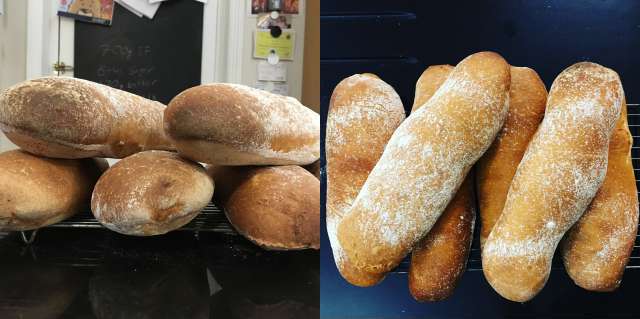Italian baking, and Italian bread in general, tends to be a lot more relaxed than French baking.
Where a Parisian baguette must have a specific number of slashes, and be baked to a certain hue and uniformity, an Italian ciabatta ‘passes’ if it looks vaguely like a slipper. Italian bread is a lot more rustic, and this stirato, the Italian version of the French baguette is a classic example of that.
It lacks the slickness, the sleekness, of its French cousin, but gains an artisan quality and an individuality that’s quite endearing.
I like this.
It means that my ham-fisted attempts to shape baguettes are fine here, where they would be laughed out of any French bakery. A slightly wonky Italian baguette is not a problem, nor should it be.
A stirato is made with a pre-ferment called a biga. This is really a method of boosting the taste and flavour of the finished loaf by developing a starter dough well in advance that will eventually be used as the base of the final dough.
The starter dough, or biga, is a stiff, fairly dry dough made with a small amount of yeast and allowed to ferment slowly in the fridge for anything up to sixteen hours. The result is a very ripe dough that shares some characteristics with a sourdough starter – both give that spine and backbone to a bread that’s generally missing from a loaf made the from a dough that’s simply mixed, risen, knocked back, shaped and proved over the space of a few hours.
A biga is typical of Italian baking, a poolish of French. The main difference is that a poolish has more water and is therefore looser. It does the same job, but doesn’t ‘hold’ as well in its ripe state.

In terms of fitting these extended periods of time around a busy life, I’ve found that making the biga first thing in the morning, say at 7am and starting to bake after work in the evening, at perhaps 6pm, works out fairly well.
To make the dough, transfer the biga to a mixing bowl and add 280g of lukewarm water. Break the biga up with a spoon or spatula, and let it soften in the water for a few minutes. Add 400g of plain flour, 5g of instant yeast, and 10g of salt and mix to a rough dough.
Let the dough rest for five or ten minutes before kneading, either by hand or in a mixer, for up to fifteen minutes, or until the dough is very elastic and the gluten well-developed.
Cover the bowl with cling film again, and let the dough rise for an hour and a half to two hours, or until it’s doubled in size.
After this bulk fermentation has completed – this is effectively the second rise, the first having occurred in the fridge earlier – it’s time to shape the loaves.
Use a dough scraper, if you have one, or a knife, to cut the dough into two equal halves, cover them with cling film and let them rest for ten minutes before shaping.
Shaping a baguette is easy – start by patting the dough into a rectangle measuring about 8cm by 13cm, and then, with the long side facing you, pull the far edge over and press it into the dough about a third of the way down, then do the same from the bottom, so that you’ve got a neatly overlapped bundle of dough. Now fold the dough in half again, top to bottom, and press down on the edges where they meet to seal them.
 Next, stretch the dough out into the shape of a baguette by gently rocking it backwards and forwards, stretching it out to about 35cm in length. Leave the ends rounded and stubby.
Next, stretch the dough out into the shape of a baguette by gently rocking it backwards and forwards, stretching it out to about 35cm in length. Leave the ends rounded and stubby.
Carefully lift each baguette onto a single piece of well floured baking paper (reusable silicone mats are ideal and reduce the risk of the bread sticking, in my experience), and let the baguettes prove for at least 45 minutes, and for up to an hour.
To bake, heat the oven to 230c and place a baking stone on a rack, if you have one. Use a baker’s peel or a flat baking tray to slide the baguettes on their paper straight onto the stone, spray the oven liberally with water from a plant mister to create steam and shut the door.
Bake for twenty to thirty minutes until the bread is a golden honey colour.
Let the baguettes cool completely before slicing or tearing into chunks. The crust will be beautiful and lightly crisp, with a soft interior. It’s very different to a French baguette, despite the fact that it’s made with exactly the same ingredients, such is the magic of making bread.
This recipe comes from Daniel Leader’s authoritative book, Local Breads: Sourdough and Whole Grain Recipes from Europe’s Best Artisan Bakers, which has become as close to essential as any book could become in my kitchen.

